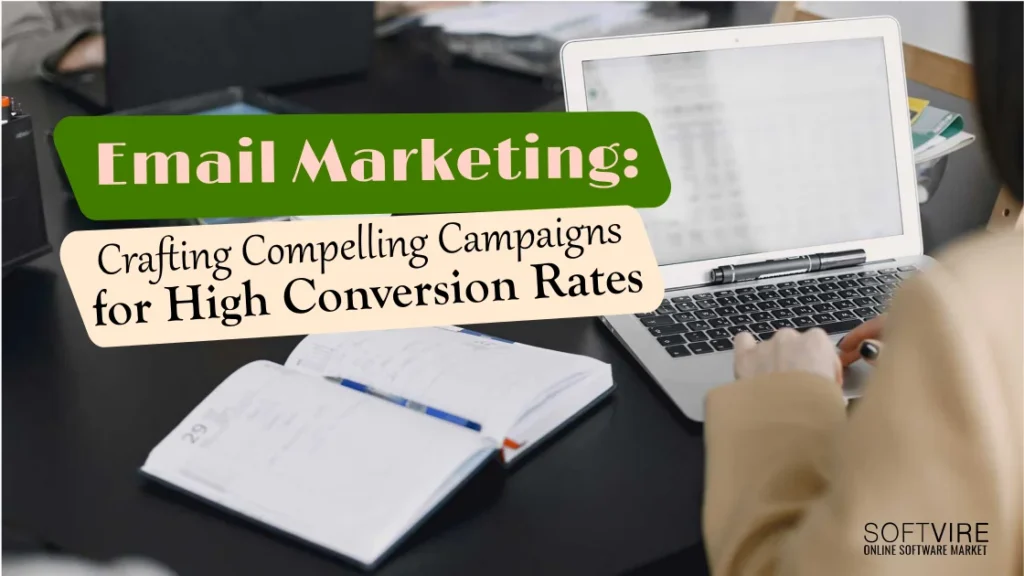I. Introduction
A. Definition and importance of email marketing: Email marketing refers to sending targeted promotional messages to individuals via email. It is a highly effective and cost-efficient marketing strategy that allows businesses to communicate directly with their audience, build relationships, and drive conversions.
B. Significance of high conversion rates in email marketing: High conversion rates indicate the success of email marketing campaigns in driving desired actions from recipients, such as making a purchase, signing up for a service, or engaging with content. Businesses must craft compelling email campaigns to maximize conversion rates and achieve marketing objectives.
C. Overview of the outline: The outline provides a structured approach to understanding and implementing email marketing strategies for achieving high conversion rates. It covers various aspects of email marketing, including list building, content creation, campaign implementation, maximizing conversion rates, nurturing customer relationships, measuring performance, and addressing challenges.
II. Understanding Email Marketing
A. Definition and scope of email marketing: This section explores the definition of email marketing and its scope in the overall marketing landscape. It emphasizes the benefits of using email as a marketing channel, including its wide reach, personalization capabilities, and cost-effectiveness.
B. Benefits and advantages of email marketing: Here, the focus is on highlighting the advantages of email marketing as a powerful tool for businesses. These benefits include direct communication, targeted messaging, measurable results, and the ability to build long-term customer relationships.
C. Email marketing statistics and industry trends: This subsection provides relevant statistics and trends in email marketing. It covers open, click-through, conversion rates, industry benchmarks, and emerging trends in email marketing strategies.
III. Building an Effective Email List
A. Strategies for growing and expanding an email list: This section discusses various techniques to build a robust email list, such as creating compelling lead magnets, optimizing website sign-up forms, leveraging social media, and using partnerships or collaborations for list growth.
B. Segmenting the email list for targeted campaigns: Segmenting an email list allows businesses to send tailored messages to specific groups of subscribers based on their interests, demographics, or past behavior. This subsection explores the importance of list segmentation and guides effective segmentation strategies.
C. Importance of permission-based marketing and compliance with regulations: Respecting recipient privacy and obtaining proper consent is essential in email marketing. This part emphasizes the Significance of permission-based marketing, including obtaining opt-ins, following anti-spam regulations (e.g., CAN-SPAM Act, GDPR), and maintaining a good sender reputation.
IV. Crafting Engaging Email Content
A. Understanding the target audience and their preferences: Effective email marketing begins with thoroughly understanding the intended audience. This subsection delves into conducting audience research, developing buyer personas, and using customer data to create relevant and engaging email content.
B. Writing compelling subject lines to increase open rates: Subject lines are critical in email open rates. This part explores best practices for crafting attention-grabbing subject lines, including personalization, urgency, curiosity, and clarity, to entice recipients to open the emails.
C. Designing visually appealing and mobile-friendly email templates: Visual presentation is crucial for email engagement. This section provides insights into designing visually appealing and responsive email templates, ensuring they render well across different devices and email clients.
D. Creating personalized and relevant email content: Personalization is key to email marketing. Here, the focus is on creating personalized email content that resonates with recipients’ interests, preferences, and past interactions with the brand. It covers dynamic content, personalized recommendations, and segmentation-based messaging.
E. Using persuasive and compelling copywriting techniques: Compelling copywriting is essential to drive action in email campaigns. This subsection explores persuasive writing techniques, including storytelling, benefits-driven messaging, compelling CTAs, and social proof, to motivate recipients to take the desired actions.
V. Implementing Effective Email Campaigns
A. Setting campaign objectives and goals: Clearly defining campaign objectives is crucial for success. This section guides businesses on setting specific, measurable, achievable, relevant, and time-bound (SMART) goals for their email campaigns.
B. Selecting the right email marketing platform and tools: Choosing the right email marketing platform is vital for campaign management. This part provides insights into evaluating and selecting email marketing platforms and tools based on features, scalability, analytics capabilities, and integration options.
C. Automating email campaigns for efficiency and scalability: Email automation streamlines campaign execution, saves time, and improves efficiency. This subsection discusses the importance of automation, including welcome sequences, drip campaigns, and triggered messages, and provides tips for setting up automated workflows.
D. A/B testing and optimizing email campaigns: A/B testing is useful for optimizing email campaigns. Here, businesses learn about testing elements like subject lines, CTAs, visuals, and content variations to identify the most impactful strategies for driving conversions.
E. Integrating email campaigns with other marketing channels: This subsection explores the value of integrating email campaigns should be combined with other marketing platforms, such as social media, content marketing, and advertising, to create cohesive and multi-channel customer experiences.
VI. Maximizing Conversion Rates
A. Strategies for improving click-through rates (CTR): Click-through rates are crucial for measuring email engagement. This section presents strategies for optimizing CTRs, including clear and compelling CTAs, concise and scannable content, prominent links, and mobile-friendly designs.
B. Designing effective call-to-action (CTA) buttons: The design and placement of CTAs greatly influence conversion rates. Here, businesses learn best practices for designing visually appealing and persuasive CTAs that stand out and encourage recipients to take action.
C. Implementing personalized recommendations and offers: Personalized recommendations and offers can significantly impact conversion rates. This part discusses techniques such as product recommendations, personalized discounts, and tailored content based on recipient preferences and past behavior.
D. Leveraging social proof and testimonials: Social proof, such as customer reviews and testimonials, can build trust and influence purchase decisions. This subsection explores effectively incorporating social proof into email campaigns to increase conversions.
E. Utilizing urgency and scarcity techniques: Creating a sense of urgency or scarcity in email campaigns can drive immediate action. This section delves into techniques such as limited-time offers, countdown timers, and exclusive promotions to encourage recipients to act promptly.
VII. Nurturing Customer Relationships through Email
A. Welcome and onboarding email sequences: The onboarding process sets the stage for a positive customer experience. This part discusses the importance of welcome and onboarding email sequences, providing tips for creating engaging and informative emails that guide new subscribers or customers.
B. Drip campaigns for lead nurturing and engagement: Drip campaigns enable businesses to nurture leads over time, build relationships, and increase engagement. This subsection explores the concept of drip campaigns and provides strategies for creating relevant and timely email series.
C. Re-engagement campaigns for inactive subscribers: Re-engagement campaigns help win back inactive subscribers who have lost interest. Here, businesses discover techniques for identifying and segmenting inactive subscribers and implementing re-engagement campaigns to rekindle their interests.
D. Customer retention and loyalty programs: Customer retention is crucial for long-term success. This section explores leveraging email marketing to foster customer loyalty, including exclusive offers, personalized rewards, and proactive communication to strengthen relationships.
E. Feedback and survey emails for gathering insights: Feedback and survey emails allow businesses to gather valuable customer insights. This subsection discusses the importance of feedback and survey emails and best practices for designing and implementing effective feedback mechanisms.
VIII. Measuring and Analyzing Email Performance
A. Key metrics to track in email marketing: Tracking and analyzing email metrics provide valuable insights into campaign performance. This part outlines key metrics, including open rates, click-through rates, conversion rates, unsubscribe rates, and revenue attribution, and emphasizes their Significance in evaluating success.
B. Email analytics and reporting tools: The right tools are essential for effective performance measurement. Here, businesses explore popular email marketing platforms and third-party tools that provide robust analytics capabilities for tracking and reporting email metrics.
C. Analyzing and interpreting campaign performance: Once the data is collected, analyzing and interpreting the campaign performance is crucial for making informed decisions. This subsection guides evaluating email metrics, identifying trends, and extracting actionable insights for campaign optimization.
D. Using data to make informed decisions and optimizations: Data-driven decision-making is key to improving email marketing effectiveness. This part explores strategies for leveraging data to optimize email campaigns, including content personalization, segmentation refinements, and iterative improvements based on performance insights.
IX. Addressing Email Marketing Challenge
A. Avoiding spam filters and optimizing deliverability: Deliverability is a common challenge in email marketing. This section discusses best practices for avoiding spam filters, maintaining a good sender reputation, and optimizing email deliverability to ensure emails reach recipients’ inboxes.
B. Managing unsubscribes and maintaining list hygiene: Unsubscribes are an inevitable part of email marketing, but managing them effectively is crucial. Here, businesses learn how to handle unsubscribe requests, maintain list hygiene, and implement strategies to minimize unsubscribes.
C. Overcoming email content and design challenges: Creating engaging email content and designs can be challenging. This subsection provides tips for overcoming common content and design challenges, such as optimizing for different devices, managing rendering issues, and ensuring accessibility.
D. Ensuring compliance with email marketing regulations: Compliance with email marketing regulations is essential for maintaining a trustworthy and ethical approach. This part explores legal considerations, such as anti-spam laws (e.g., CAN-SPAM Act, CASL) and data privacy regulations (e.g., GDPR), and guides ensuring compliance.
Conclusion:
Compelling email campaigns are crucial for driving high conversion rates and business success. Personalization, clear objectives, and strategic optimization are essential. By leveraging email marketing effectively, businesses can build relationships, generate conversions, and achieve marketing goals.
Check out the different Microsoft software products today if you need trusted software that uses AI ethically and efficiently. They continue to lead in using AI for their many office tools like Office 365. Get discounted Office 365 in Australia now!



